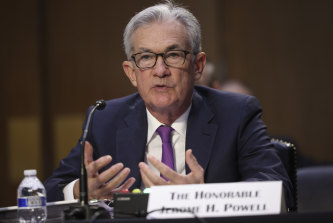Markets had become blase about the COVID threat. Omicron changed that in an instant
Copper prices were down about 4 per cent but the gold price was steady, signalling that the emergence of Omicron has, momentarily at least, overwhelmed the concerns about raging inflation rates that had increasingly dominated discussion about economic settings this year.
For markets, that’s a key takeout from what happened last week.
Where it was a given that the Fed would unwind its $US120 billion ($168 billion) a month of bond and mortgage purchases by the middle of next year at the latest and clear the way for the first rate rises in the post-pandemic cycle – with other major central banks moving, more or less, in tandem – Omicron has abruptly changed that conviction.

Newly reappointed Fed chair Jerome Powell may have to change his thinking.Credit:Getty
Newly reappointed Fed chair Jerome Powell and his new senior deputy, Lael Brainard are both relatively “dovish” (Brainard even more so than Powell) and are likely to adopt a cautious response to the threatening new mutation of the virus.
Where, a week ago, the Fed’s minutes of its most recent meeting showed some discussion about accelerating the tapering of its asset purchases to clear the way for an earlier-than previously planned first rate rise, now the discussion will be on whether to slow or halt the tapering despite the sustained high levels of US inflation (and similar experiences elsewhere).
It’s the prospect of more lockdowns and other economy-disrupting measures that spooked the markets and will give central banks, other economic agencies and governments significant pause for thought.
Relatively high vaccination rates in the developed world, a better understanding of COVID and well-developed responses over the past 18 months mean the world is somewhat better prepared for a dangerous mutation than it was when the pandemic started.
Markets were initially highly sensitive to COVID-related developments but, as vaccination rates in the developed world rose, investors – indeed communities – had become increasingly blasé about its threat. That all changed last week.
Equally, however, governments and their central banks have used up most of the fiscal and monetary policy firepower they had for their initial response to COVID.
The chronic supply chain disruptions that have been a factor in the biggest surge in inflation rates for more than 30 years are going to be exacerbated by Omicron if the worst fears about the variant are realised, creating a novel and very difficult to reconcile conundrum for economic agencies trying to balance the trade-offs between growth and persistently high inflation.
China’s “COVID-zero” approach to COVID, itself a key factor in those supply-side disruptions, could mean even greater shortages of goods if there’s even a hint of the mutation gaining a foothold within its communities.
The sectors hit hardest by the pandemic – restaurants, entertainment, accommodation and travel (aviation in particular) – were only just starting to recover and re-start services. Another suite of lockdowns would be devastating, and not just for the share prices of the listed entities.
For the US sharemarket, which is trading about 36 per cent higher than it was pre-COVID (our market is broadly in line with its pre-COVID level) the new outbreak is threatening.
There was little if any downside risk priced into the market before last Friday; not even a recognition that US monetary policy had started to shift and would gradually shrink the enormous bulge of liquidity the Fed has pumped into the US financial system since March last year.
With a lot of retail and first-time investors in the market, many of them drawn in by the no-fees brokerages like Robinhood and trading on margin or playing with call options, there is the potential in the US – and elsewhere, given the role the US market plays within global markets – for something quite unpleasant to occur if the Omicron variant turns out to be as transmissible, and the vaccines’ efficacy against it as weak, as some immunologists fear.
What the emergence of the latest variant does do is remind everyone that there is no smooth path to the “COVID-normal” that was previously envisaged.
Loading
Markets were initially highly sensitive to COVID-related developments but, as vaccination rates in the developed world rose, investors – indeed communities – had become increasingly blasé about its threat. That all changed last week.
The Market Recap newsletter is a wrap of the day’s trading. Get it each weekday afternoon.
For all the latest Business News Click Here
For the latest news and updates, follow us on Google News.
